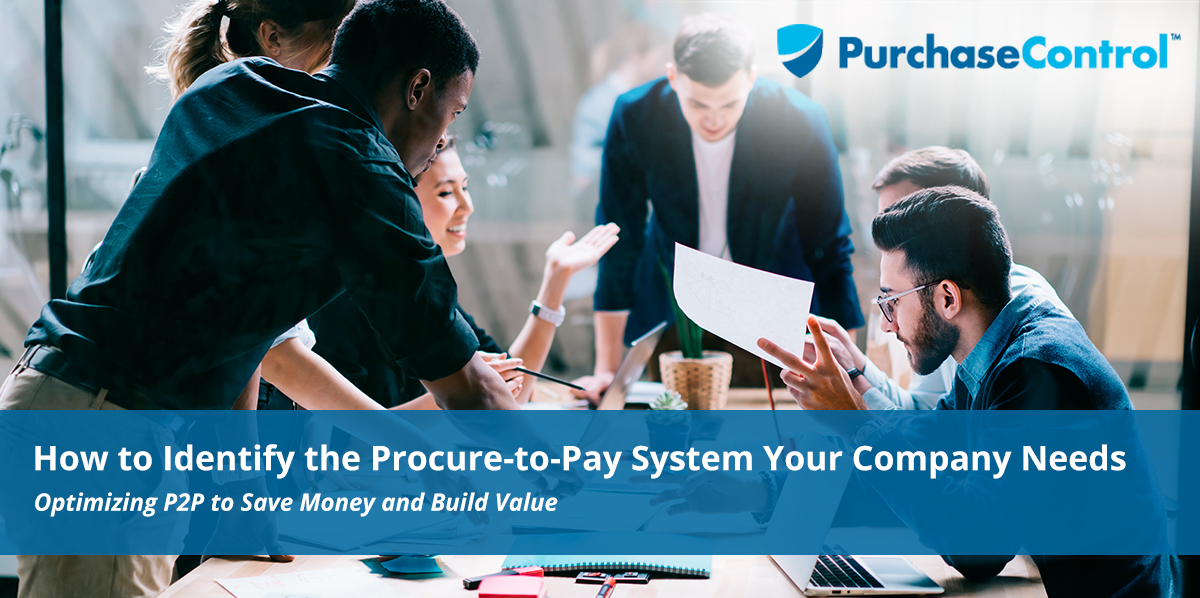No matter how well your business processes are performing, there’s always room for improvement within your process flow. With strategic decision making increasingly supported by evolving technologies such as big data analytics, automation, and artificial intelligence, many companies are looking to optimize competitive advantage and profitability by building smarter, more responsive software environments focused on continuous improvement. And because it touches every part of your business, optimizing the procure-to-pay process (sometimes called the P2P process or purchase-to-pay process) is especially important.
To achieve this optimization and reap the attendant gains in productivity, profitability, and efficiency, you need the right procure-to-pay solution. As with many other products, procure-to-pay systems are available in a wide range of configurations and capabilities. To find the best one for your business, you need to understand how to evaluate procurement software and select the package that meets your budgetary and performance needs.
What is a Procure-to-Pay System?
Since the turn of the 21st century, digital transformation has made significant inroads into all areas of business, including the P2P process. What was once a long, tedious, and costly set of manual workflows, susceptible to disruption and corruption at every turn, has evolved into a much sleeker, more efficient, and productive process thanks to the growing use of eProcurement software such as procure-to-pay systems.
The P2P process itself covers three specific areas:
- Procurement
- Vendor evaluation and selection.
- Request for Proposal (RFP) or purchase requisition (internal).
- Contract negotiation.
- Purchase order process.
- Goods and services received and recorded (goods receipt).
- Invoicing
- Supplier invoices buyer (may include eInvoicing)
- Three-way matching and exception reconciliation
- Invoice approval.
- Payment
- Payment approval workflows.
- Payment issued via accounts payable.
- Accounting records updated.
The goal of any procure-to-pay system is simple: use technology to automate and refine the P2P process. The specific goals supported by implementing eProcurement software may differ by organization, but in general they include items such as:
- Improving cash flow.
- Eliminating fraud and maverick spend while achieving total spend visibility.
- Optimizing business processes to reduce waste, eliminate human error, and improve productivity.
- Strategic spending supported by transparent supply chain management.
- Implement continuous improvement into all workflows and, in time, engage all business units in similar process optimization in support of company goals.
- Transforming the purchasing department from a source of minimal savings to a reliable source of added value.
Two of the most common reasons a company researches and implements a procure-to-pay system are:
- The company is taking measures to embrace digital transformation by upgrading outdated, manual workflows. This often requires a significant culture shift, particularly in companies driven by tradition over innovation. The procurement team will likely need to make a convincing case to the C-suite in order to begin the process, and implement educational and training efforts before, during, and after the transition to ensure total buy-in from the company and reinforce both the reality of the change and the support it receives from “upstairs.”
- The company has an existing, but outdated enterprise resource planning (ERP) system that’s being upgraded to meet evolving needs. In its prime, the solution the company is currently using offered a significant boost in performance compared to the waste, delays, and frustration of paper-based processes. It might even have a few forward-looking features, such as integration with your accounting system or real-time alerts for approvals.
But now it’s a little long in the tooth, and maintaining competitive ability, productivity, and a healthy bottom line in today’s competitive, automation-driven marketplace is simply beyond its capabilities. Depending on company culture, this transition may be less difficult for the procurement team to accomplish, as it’s an upgrade that isn’t quite as jarring to management or staff as the leap from manual processes to digital. Training and education efforts will likely still be required, but may not be as onerous. Nevertheless, the C-suite will expect, and demand, a solid business case for making the switch, and a clear explanation of why and how doing so will benefit the business.
“Following your intuition works fine as a method for choosing, say, where to eat lunch with friends. But when it comes to a major process transformation such as selecting and implementing a procure-to-pay system, it’s time for needs analysis.”
Finding the Right Procure-to-Pay System for Your Business
Following your intuition works fine as a method for choosing, say, where to eat lunch with friends. But when it comes to a major process transformation such as selecting and implementing a procure-to-pay system, it’s time for needs analysis. Identifying the areas most in need of attention and improvement is the first step to finding the procurement software that will best address those needs.
It’s unlikely, for example, that a small, mom-and-pop business will have a need for an enterprise-level procurement solution built to handle everything from production inventory to vendor portal creation. Conversely, a large business looking to optimize its entire P2P process probably won’t gain optimal benefit from choosing a single, stand-alone module designed for purchase requisitions alone. The “right” answer lies in identifying your needs and then finding a service provider who acknowledges, understands, and meets them in a collaborative way.
Before considering any P2P solution, ask:
What is the state of our current P2P process? You can’t measure, fix, or streamline what you can’t see or quantify.
Which procurement processes need to be optimized? Does your company need to add new capabilities to an existing software environment, or are you a paper-and-pencil firm looking to make the leap to digital spend management? Are you testing the waters by starting with a single process, such as purchase order optimization, adding multiple modules at once, or replacing an outdated solution? Do you need a way to gain comprehensive control over your entire supply chain with strategic sourcing tools, or a dedicated contract management solution?
Which issues take priority? For some companies, taming maverick spend and tidying up their supply chain is job one. Others may have an existing ERP system in place for handling payments, and need a reliable (and compatible!) solution that will automate everything that falls between the purchase requisition and the final invoice.
Which stakeholders are essential to the success of this transformation? From upper management to the staff using the new system to procure goods and services, identifying and engaging with everyone essential to the process before, during, and after the switch gives you a much stronger chance of a successful implementation.
What is our budget and timeframe for research, implementation, and follow-up? Finding a provider who will take the time to map out a course with you while also providing training and educational content can shorten your timeframes, reduce costs, and minimize downtime while increasing user performance and compliance.
PurchaseControl, for example, collaborates with clients to provide purpose-built software solutions that address current needs while leaving room for future growth.
What’s our perfect F.I.T.? When it comes to evaluating potential procure-to-pay software candidates, just remember the right system will have the Features, Integration, and Transparency you need.
Features vary, but best-in-class P2P systems share certain common features, such as:
- Cloud-based data collection and management
- Mobile-friendliness for improved communication and collaboration regardless of location
- Process automation and intelligent data analytics with real-time access to data for review, sharing, and analysis
Integration is key, both internally and externally. Beyond ensuring your new procure-to-pay software will “play nicely” with your existing accounting software, ERP, customer resource management (CRM), and other software, effective integration minimizes workflow disruptions during the transition, saving you time, money, and effort. In addition, solutions designed for versatility with regard to integration are more future-proof than those with little or no external integration options.
Another important aspect of integration is supplier integration. If you’re prioritizing invoice reconciliation and invoice matching, choosing a solution that accommodates your vendors with support for eInvoicing helps further reduce the invoice lifecycle and capture more discounts. Tracking and reviewing vendor compliance and performance is easier with a P2P package that features a dedicated supplier portal that connects their systems with yours.
Transparency is essential, regardless of the scope of your project. Full visibility brings improved decision making and process efficiency, whether it’s spend, processes, or supplier relationship management you’re optimizing.
Streamlined P2P is the Secret to an Optimal ROI
Maybe you’re a small business looking to capture savings and value through automation with a basic purchase order management package. Perhaps you’re the CFO for a major conglomerate that’s ready to modernize its entire procurement function with artificial intelligence, process automation, and deep analytics. Whatever the case, choosing and implementing a procure-to-pay system that fits your budget, culture, and goals can help you lay the foundation for bigger profits, greater productivity, and an optimal return on not just your P2P system, but every purchase you make.
Perfect Your Procure-to-Pay Process with Powerful and Intuitive Software from PurchaseControl
Find Out How








